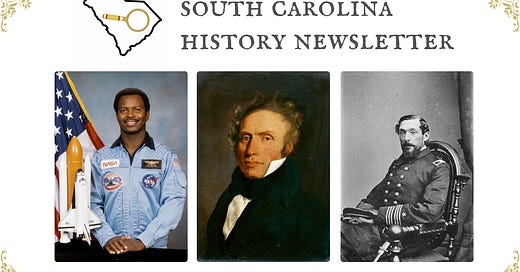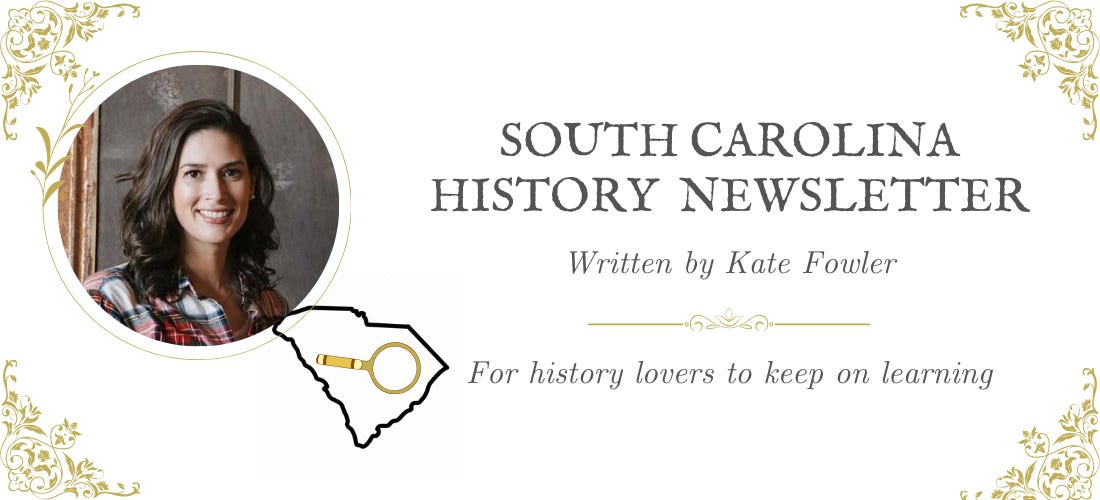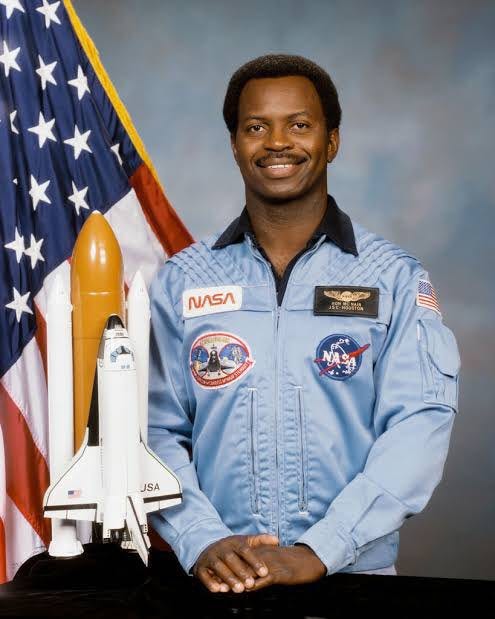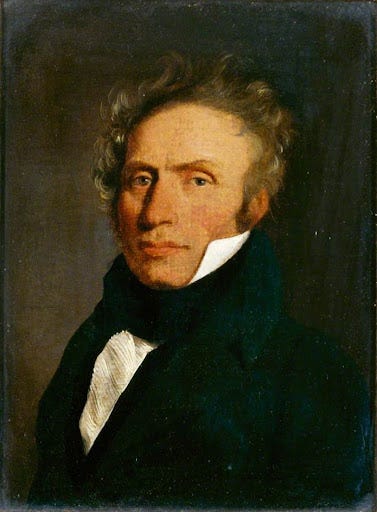#23: A hero & astronaut from Lake City, Charleston's first botanist, and Captain Percival Drayton
For South Carolina history lovers far and wide! Enjoy weekly SC history and upcoming SC historical events
Dear reader,
Welcome to Newsletter #23 of The South Carolina History Newsletter! I’m so happy you’re here.
Welcome “gardeniaprincess” “tandkgrant” “rotate1800” and “roddysmithsr” to our SC History Newsletter community! Woohoo!
I hope you enjoy today’s newsletter, and as always, please feel free to reply to this email with your ideas and suggestions on South Carolina history you’d like to learn more about. I’m only a click away.
Additionally, please join us & keep the conversation going by becoming a member of our SC History Newsletter Facebook Community here! I can’t wait to meet you.
And now, let’s learn some South Carolina history!
Yours truly,
Kate
(Writing from Greenville, SC)
3 ➳ Upcoming SC History Events
While I have curated the following 3 events below to feature in today’s newsletter, please click here to visit my SC History Events Calendar that organizes all the events I have featured in the newsletter to date, as well as others I have discovered. Please let me know if you’d like to add an event to the list! Reply to this email or send me a note at schistorynewsletter@gmail.com.
I.
Friday, March 8th from 11:00 am - 12:00 pm | “Civil War History Program: John Witherspoon as Captain Percival Drayton” | Hilton Head Branch Library | Hilton Head Island, SC | FREE & Open to the public
“Join us for a special local history presentation with living historian John Witherspoon as he portrays U.S. Navy Captain Percival Drayton and gives a first-person account of how the Civil War impacted and divided the Drayton Family. This program is presented by the Friends of the Hilton Head Library. No reservations necessary. Open to all ages. Contact the reference desk at 843-255-6525 for more information.”
II.
Tuesday, March 19th from at 11:00 am | “Lunch & Learn: Oconee History for Newcomers” | Oconee History Museum | Walhalla, SC | FREE & Open to the public
“Bring your lunch and learn more about local history! New to the area? Come join us to learn more about the history of your new county! Interim Director/Curator Jennifer Moss will explore all aspects of Oconee County history from the Cherokee to the construction of the lakes. It will be a fun learning opportunity. Although this program is geared towards newcomers, everyone is welcome to this program. This program is FREE but donations are highly encouraged.”
III.
Thursday, March 28th from 9:15 am - 11:30 am | “Morning History Walk” | Tour starts at Shop Historic Charleston | Charleston, SC | TICKETS: Adults: $35, Children (6-12): $10, Children less than 5: $0
“Led by Charleston’s most experienced certified guides, these two-hour walking tours of the Old & Historic District provide the perfect background for the afternoon or evening house and garden tours. Private sites and interiors are not included on these tours. These tours depart from Shop Historic Charleston at 108 Meeting Street. Please arrive by 9:15 am to check-in for a prompt 9:30 am departure.”
2 ➳ SC History Fun Facts
I.
Did you know that Ronald Edwin McNair from Lake City, South Carolina was a NASA astronaut, the second African American to travel to space, and also a 5th degree black belt in karate?
Ronald Edwin McNair was born in Lake City, SC in 1950 and started doing extraordinary things at a young age. Age 9, he refused to leave the segregated Lake City Public Library without being allowed to check out his books. It was only after the police and his mother were called that young McNair was able to check out his library books. Consequently, the library in Lake City that initially refused to help him, is now named after Ronald McNair.
McNair was brilliant in his studies. He graduated valedictorian of Carver High School in 1967, received a Bachelor of Science in engineering physics, magna cum laude from North Carolina Agricultural and Technical State University, and in 1976, received a PhD from Massachusetts Institute of Technology and became “nationally recognized for his work in the field of laser physics.” McNair would go on to receive four honorary doctorates, as well as a score of fellowships and commendations. Also in 1976, McNair won the AAU Karate gold medal. He would subsequently “win five regional championships and earn a fifth-degree black belt in karate.”
In 1978, McNair was selected as “one of 35 applicants from a pool of 10,000 for the NASA astronaut program.” McNair was one of several astronauts recruited through NASA’s efforts to increase the number of minority and female astronauts in their program. From February 3 to 11, 1984, McNair flew as a mission specialist on STS-41-B aboard Challenger, becoming the second African American to fly in space.
Sadly, his career as an astronaut came to a tragic end in 1986. Following the STS-41-B mission, McNair was selected for STS-51-L as one of three mission specialists in a crew of seven. The mission launched on January 28, 1986. He and the other six crew members were killed “when Challenger disintegrated nine miles above the Atlantic Ocean, 73 seconds after liftoff.” McNair was posthumously awarded the Congressional Space Medal of Honor in 2004, along with all crew members lost in the Challenger and Columbia disasters.
Not only was McNair a brilliant scientist, but he was also an accomplished saxophonist and jazz enthusiast. As he prepared to launch with the Challenger mission, it had been McNair’s intention to record himself playing the saxophone in space, but it wasn’t to be.
Many K-12 high schools, college academic buildings, boulevards, and more are named in Ronald Edwin McNair’s honor across the country. There is also crater of the moon named for him, the McNair crater.
Here is also an inspiring video of Ronald McNair delivering the 1984 commencement speech at the University of South Carolina:
II.
Did you know that in the late 1700s, French botanist André Michaux was the first to chronicle the native plant species of South Carolina?
Born in France in 1746, André Michaux was commissioned as royal botanist to “find useful plants for France in America.” He originally landed in New York, and arrived in Charleston in 1786; thereafter, the city became the base of his operations. In his studies, Michaux traveled all over North American, “as far south as Florida and as far north as Hudson Bay.” Among his travels, the “Carolina mountains were among his favorite areas for botanizing.” South Carolina plants first described or collected by Michaux include:
The Oconee bell
The big leaf magnolia
Native cane
Blue-eyed grass
Carolina willow
In all, Michaux is responsible for categorizing “188 species native to the Carolinas.” He created a 111-acre botanical garden near Charleston, which showcased his botanical findings, and became a popular visiting place for local residents. He was also a member of the Agricultural Society of South Carolina, and worked to acclimate foreign plants, mostly Asian, in America, including “the camellia, the mimosa from Persia, the gingko tree from China, and the crape myrtle from India.” So the next time you see a row of colorful crepe myrtles, or a sparkling gingko tree in your travels across South Carolina, you can thank Andre Michaux!
1 ➳ Quote from an SC historical figure
I.
“The true courage of space flight is not strapping into one’s seat prior to lift off, it is not sitting aboard 6 million pounds of fire and thunder, as one rockets away from the planet — but the true courage, comes in enduring…persevering, the preparation, and believing in oneself."
—Ronald Edwin McNair, NASA astronaut and native of Lake City, South Carolina
Sources used in today’s newsletter:
I always want to improve my work. Answer the poll below to give me your review of today’s newsletter. I also welcome your suggestions for new content! Simply reply to this email with your ideas. Thank you!












